David's Astronomy Pages
Notes - Session 555 (2013-11-18)
Notes
(S512)
Notes
Main
Home
Page
Notes
(S556)
David's Astronomy Pages
|
Notes (S512) |
Notes Main |
Home Page |
Notes (S556) |
2013-11-18 New Imaging Setup with AO-8 (adaptive optics system) First Light using AO-8 (M33 - Spiral Galaxy) Focusing Flats Imaging Improvement Plan Images from 2013-11-18 >>
After laying in its box since 2009 the AO-8 adaptive unit was finally added into the imaging train on 2013-11-16 (between sessions 554 and 555).
| 12" LX200R - with imaging equipment setup including AO-8 unit (Late 2013) |
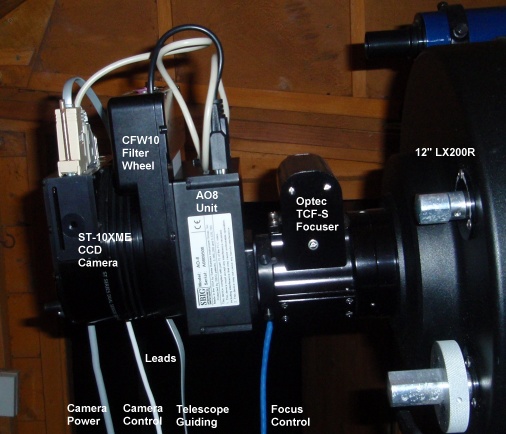
|
| [Larger Image (not annotated)] |
Besides the addition of AO-8 unit the back plate of the CCD camera was reinserted to increase the distance between the ST-10XME's CCD and the Filter Wheel with Star Analyser 100 diffraction grating. Whilst this adds an additional window into the train, the aim is to increase Dispersion Value (& Plate Scale) when taking Spectra.
Back to Top
Calibration of AO-8 produced the following results
| CCD | Motion (pixels at 100% deflection) | Notes | |
| Main chip | 48 pixels at 1x1 | 24 pixels at 2x2, 16 pixels at 3x3 | |
| Autoguider |
Back to Top
First light image taken using the benefit of the AO-8 unit, was the following stacked image of the southern part of M33. The conditions was rather poor for imaging (due to poor sky transparency), but despite that the AO-8 successfully auto-guided on a 8th magnitude star to produce the image below.
|
M33 (Triangulum) |
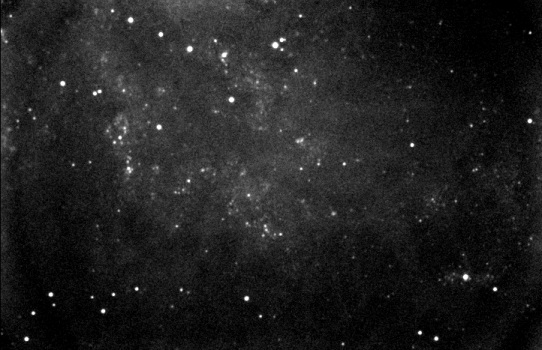 |
| CCD Image (Linear Brightness Scale, 75%
size) 10 x 180s exposure (average combine), 3x3 binning, C Filter Autoguided on mag 8 guide star using AO-8 2013-11-18 20:25hUT (#555079-90) 12" LX200R (at f/10.4) + ST-10XME |
|
Single raw frame for comparison |
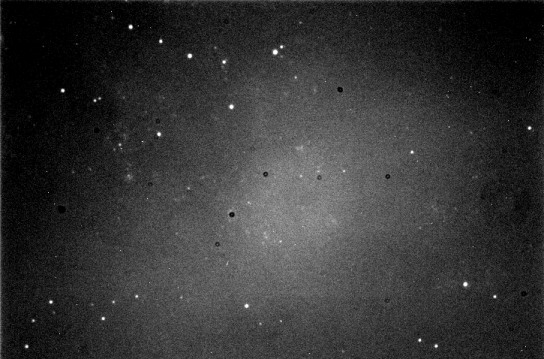 |
| CCD Image (Linear Brightness Scale, 75%
size) Autoguided on mag 8 guide star using AO-8 2013-11-18 20:25hUT (#555079) 12" LX200R (at f/9.7) + ST-10XME |
Back to Top
Telescope was focused on star at Airmass 1.07 with C Filter in place. This gave the following focus profile. Peak FWHM was 2.67 arc secs.
|
Focus Profile- C Filter |
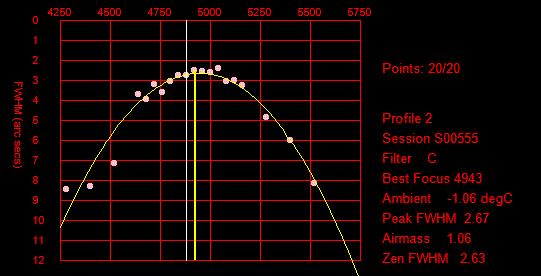 |
Using the same star the focus offsets (ie focus position offsets from C) where determined for each principal filter.
| Profile | Filter | Filter Offset | Temp | FWHM | Filter Offset (f/10.4, AO8) |
| 1 | C | 4898 | -0.61 | 2.9 | |
| 2 | C | 4943 | -1.06 | 2.7 | |
| 3 | V | 4870 | -1.28 | 2.6 | -84 |
| 4 | B | 4817 | -1.47 | 2.6 | -147 |
| 5 | C | 4975 | -1.66 | 2.9 | |
| 6 | R | 4922 | -1.81 | 2.7 | -61 |
| 7 | I | 5095 | -1.97 | 2.6 | 107 |
| 8 | S | 4377 | -1.78 | 3.2 | -601 |
| 9 | Ha | 4519 | -1.69 | 2.5 | -454 |
| 10 | S | 4326 | -1.71 | 3.4 | -647 |
A comparison with previously used focus offsets is shown in the table below.
| Filter No. |
Filter | Filter
Offset ((f/10.4, AO8) |
Previous
Offset (f/9.7, no AO8) |
| 1 | C | n/a | n/a |
| 2 | B | -147 | -90 |
| 3 | V | -84 | -35 |
| 4 | R | -61 | -7 |
| 5 | I | 107 | 54 |
| 6 | Ha | -454 | -475 |
| 7 | g | not meas. | -707 |
| 8 | b | not meas. | -826 |
| 9 | S | -624 | -563 |
| 10 | U | not meas. | -500 |
Back to Top
At the end of the session new flats were taken using an electrolumenscence light board. Master flat frames were later built from these using Average Mean method in Beta Sigma application. A comparison of some of the new master flats with the AO-8 unit in place compared with previous master frame (without AO-8) are shown below. Attempts were made to dust/clear filters when changing the imaging setup to include AO-8.
A deterioration in the physical properties of the
V filter were noted and the flat frames confirm there is there is am issue with
the filter.
Ideally it will be swapped out for a new one, but I haven't yet seem them
sold individually.
(buying a whole new set of BVRI filters is rather expensive)
| Comparison of New Master Flat Frames (right) with previous master flats (left) | ||
| C (clear) filter | C (clear) filter | |
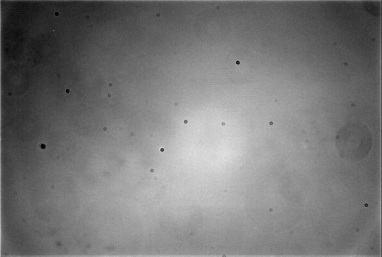 |
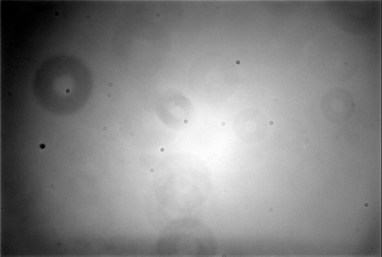 |
|
| New Master Flat (50% size) 3x3 binning, C Filter, 25 x 2s (Av. Median), S555 |
Old Master Flat (50% size) 3x3 binning, C Filter, 21 x 1.5s (Av. Median) , S515 |
|
| V filter | V filter | |
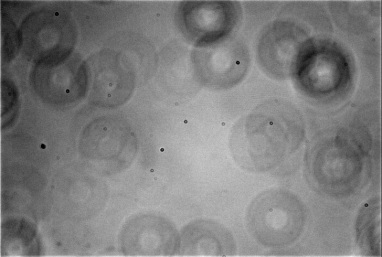 |
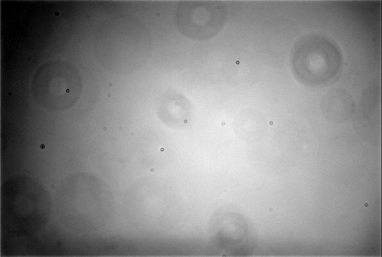 |
|
| New Master Flat (50% size) 3x3 binning, V Filter, 21 x 1s (Av. Median), S555 |
Old Master Flat (50% size) 3x3 binning, V Filter, 17 x 1s (Av. Median) , S491 |
|
| Flat Frame Analysis (performed by CCDWare) | ||
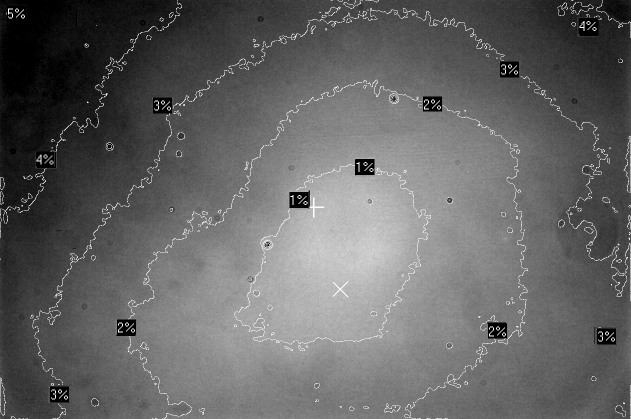 |
||
| New Master Flat () 3x3 binning, C Filter, 25 x 2s (Av. Median), S555 |
||
Back to Top
Consideration has been given to how imaging can be improved. The following improvement plan is defined. The table shows latest updates on the status of the various proposed improvements.
| No | Improvement | Intended Benefit | Description | Comments |
| 1 | Insert ST-10XME camera backplate | Improve spectral images by increasing separation between Spectra filter and CCD in order to get increased dispersion of spectral lines data | CFW10 (windowed version) is designed to attach directly to the Camera body, without the camera backplate. Whilst this reduces the total length of the imaging train, it reduces the distance between Spectra filter and CCD. Using long screws the filter wheel can be attached to the Camera body, with the camera back plate in place. The only significant drawback is that imaging has to pass through one extra window, and there might be slightly increased vignetting. | Done. 2013-Nov-16 (still awaiting quantification of benefit) |
| 2 | Clean C filter | Remove the most significant dust particles/dirt from the C filter | Whilst effects of dust mottes can largely be removed from images by taking and using Flat frames, a trace of the dust motte can still be seen in longer (60 sec+) exposures where sky background is relatively bright. | Done. 2013-Nov-16 Main troublesome dust particle removed. |
| 3 | Add AO-8 unit | Use AO-8 unit for autoguiding to get sharp star images on specific objects. | AO-8 unit was purchased in 2009 , but hadn't be immediately used. Whilst regular autoguiding hasn't generally been used as it hasn't given sufficiently reliable guide correction responses from the mount. Autoguiding should benefit my imaging, if a became more proficient with it. The AO-8 provides a means for better / faster autoguiding. | Done 2013-Nov-16 Benefits already seen in first light image(M33), but need to use more and test benefits over a more extended period. |
| 4 | LX200 firmware update to 4.2G (patched) | Autostar has 10x finer Custom Tracking Rate & remembers and restores a Custom Tracking Rate setting across power-cycles. | Firmware patch for Autostar
is available. Some risk & bother involved in making the upgrade if things go wrong: - write down all existing Autostar II settings - use \PixSoft\StarPatch\StarPatch.exe (v 1.6) - use PatchLX42ggv19 - review/select required Patch options - review/select StarPatch option, including COM port, - then click Update Autostar To recover from a mangled update, cure the root cause (throw the cat out), and then perform a Safe Load procedure: connect the cables. Turn on the telescope/Autostar, tap 999 immediately. The Autostar should come up and display: FLASH LOAD Now start the Autostar Updater or StarPatch on your PC. Restart the update (click [update autostar] on the either program). They should notice the FLASH LOAD state of the Autostar and will ask you to verify that's what's going on. Answer the questions and the Update will be re-tried. |
Done 2013-Nov-22 See Notes on Firmware Update |
| 5 | Reinstate Cloud Sensor | Monitoring of sky conditions. Reduce risk of equipment damage from rain. | Aurora cloud sensor has
stopped working. Unclear if sensor hardware, driver, or computer
problem. Got it working again once before but still to getting
reworking on this occasion. Eventually reinstalled the original Prolific PL-2303 drivers for the Serial-USB adapter that came with the Aurora Cloud Sensor. Original correspondence with Eurotech at time of purchase had stressed the importance of only using drivers directly from Prolific. (not emulations). Deleting the old driver/installing new driver also had the benefit of reducing COM ports that had reached 20 to under 10, |
Done 2013-Nov-22 |
| 6 | Cables | Tidier Observatory Reduce risk of mistake (pulling out wrong cable) Quicker troubleshooting |
Cables in the observatory
have become untidy and interweaved over time. Cables where tidied and ties redone & added. Labels were added to power plugs for quicker identification. |
Done 2013-Nov 23 |
| 7 | Cable HangUps | Reduce risk of cable/telescope damage caused by slews | Need to test mobility of scope and
review risks from cable snarl. Cable tidying on Nov 23 should help reduce problems related to long slews to the northern sky, but physical checks still need to be made No obvious problems occurred during a TPoint map run including points within 3 deg azimuth of north meridian. |
In Progress 2013-Nov-24 |
| 8 | Mouse | Smoother mouse operation | Mouse movements have started
to hang momentarily at regular intervals during recent fortnight. Not
sure if problem is with mouse, mouse driver, hardware conflicts or
software issue on laptop. Eventually determined that it was a problem with the mouse. Replaced mouse with a new one. |
Done 2013-Nov 23 |
| 9 | TPoint Mapping & Modelling |
Faster target acquisition. Accurate measurement of Polar Misalignment |
TPoint used previously with
8" LX200 classic, but not used with 12" LX200R as slew
accuracy is much better and CCD FOV is larger. Having an
efficiency can see be gained by using TPoint. TPoint will also
give a more accurate measurement of any Polar MisAlignment. In preparation for next session a .sky document file was prepared including an inserted TPoint object ready for making mapping.(2013-Nov-22) TPoint Mapping run involving 48 points was made on
2013-Nov-24. |
In Progress 2013-Dec-10 |
| 10 | Polar Alignment | Better tracking if Polar Alignment errors are minimised. Autoguiding works better. | Drift Measurements suggest
Polar Alignment is reasonably good. However improvement can still be made. Plan is - make a TPoint Map run to measure Polar Misalignment - refine polar alignment - check polar alignment after adjustment - create and use more detailed TPoint Map. TPoint Mapping made on 2013-Nov-24 which indicated Polar axis need lifting by 1.5 arc min and rotating clockwise by 2.3 arc min. This adjustment was completed on 2013-Dec-10. Awaiting a further mapping run to confirm improvement in Polar Alignment had been successful. |
In Progress 2013-Dec-10 |
| 11 | Tracking Rate | Better tracking if custom tracking rate can be used | At the moment it is difficult
to set tracking rate at start of each session (difficult/fiddley to do and setting is lost at power down). The tracking rate
adjustment is also too coarse to get the required accuracy.
The plan is to update AutoStar II firmware with patch so the x10 finer
tracking rate can be stored and recovered automatically at start of each
session. Firmware was updated to 4.2G on 2013-Nov-22. Tracking Rate was measured on 2013-Nov-27 and Rate Adjustment set to +9 (+0.09%) |
Done 2013-Nov 27 |
| 12 | Cloud Sensor (port reading) |
Better integration if cloud Sensor reading can be combined with image quality information. | The Aurora Cloud Sensor can
apparently be configured for Network Access via Port 4000 (Aurora Cloud
Sensor Network Protocol V1.0 document found on Weather-Watch website) Reading of Port 4000 was built into my CCDApp2 Observatory Program on 2013-Nov-23, with basic data display and flags added on 2013-Nov-24. Further improvements were added and successfully tested 2013-Dec-10. |
Done 2013-Dec-10 |
| 13 | Collimation | Sharper (flatter image) | Desirable to get optimal
collimation for sharper stars. Collimation is potentially ok but is overdue. One issue might be sag in imaging train related to extra weight & length due to adding AO-8 unit on 2013-Nov-16. Collimation checked on 2013-12-28. No adjustment required. |
Done 2013-Dec-28 |
| 14 | Misc Equipment | Ready access to misc equipment / options | Desirable to sort out miscellaneous and legacy equipment. | Pending |
| 15 | Tools | Ready access to tools equipment / options | Desirable to sort out tools . eg Allen Keys, mini screwdrivers, nuts/bolts etc | Pending |
| 16 | Observatory ToolBar | Quicker/easier access to key sections of Observatory Software. More visible access to alerts & flags | A new toolbar window added to
Observatory Software program (2013-11-24).
Further refinements where made 2013-11-27 to 2013-12-10,, including connectivity to Aurora Cloud Sensor and Weather Station data. |
Done 2013-Dec-18 |
| 17 | Observatory Folder | Quicker/easier access to key files relating to observatory equipment. | An "Observatory"
folder has been created on laptop to specifically contain documents
relating to observatory equipment (2013-Nov-23). Subfolder are in progress of being created and files moved in from various current sources from the 2-3 Astronomy and Computer folders. |
Done 2013-Dec-18 |
| 18 | Key Bug Fix | Smoother operation leading to quicker 1st target acquisition and more frequent/better focusing. | An annoying bug crept into my
Observatory Software some 9 months ago which causes the Imaging Job
Queue to immediately hang , if a Focusing Profile job has previously
been made. This either requires the the program to be shut-down/killed
and restarted, or a workaround is employed to exit and restart the
program before an Imaging Job Queue. Either is annoying and can
take 5 minutes or so of effort. Attempts to date to track down the
source of the bug have failed. Source of problem believed to have been identified (thread is waiting for a lock flag to be released when a) flag shouldn't be in a locked state and b) there isn't another thread or process that will release it. Nov-30th. |
Done 2013-Dec-18 |
| 19 | Weather Station (port reading) |
Better integration if weather station reading can be combined with image quality information and cloud sensor information | After integrated data from
the Aurora Cloud Sensor it occurs that it should be possible to
integrate readings from Weather Station, via dbase.csv file produced my
Virtual Weather Station.
Idea is to have a VB program running on indoor computer which would read the Virtual Weather station dbase.cvs file and send the information to a specific port that would then be read by a listening thread in the Observatory Program. Basic functionality has been written and tested. (Dec
4th Now need to incorporate readings into Observatory toolbar and add appropriate alert flags etc. |
Done 2013-Dec-18 |
| 20 | Field Rotator | Access wider number of guide stars for use by AO-8 autoguiding. | The ST237 Guide Chip in the ST-10XME is relatively small and when held in a fixed orientation with respective to the target (eg N or S) there is often no sufficiently bright star to guide on in the FOV (or not one sufficiently bright to guide on at the high frequencies that AO-8 is designed to operate at) A field rotator (Optec Pyxis LE or Optec Pyxis Field Rotator) could allow more potential guide stars to be ultilised. | Consider in 2014/2015 requires benefit #3 to be realized first |
| 21 | Dew Heater | Longer sessions with dewing of corrector plate. Less visits to observatory with hairdryer. | Dew heater and power leads
are a bit flakely. Potential to upgrade ? |
Consider for 2014 |
| 22 | Dome | Reduced dewing, Protection from wind | Consider for 2015 |
Back to Top
| This Web Page: | Notes - Session 555 (2013-11-18) |
| Last Updated : | 2015-05-15 |
| Site Owner : | David Richards |
| Home Page : | David's Astronomy Web Site |